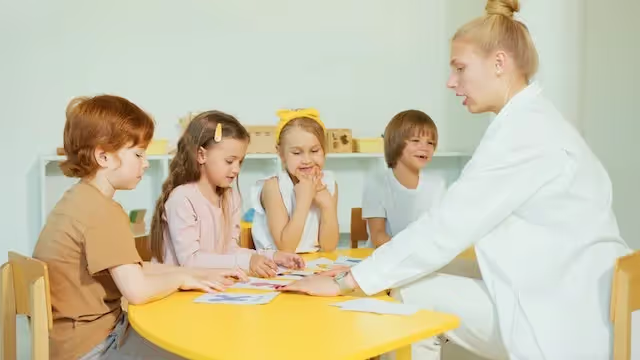Pivotal Response Treatment (PRT) In ABA Therapy
Pivotal response treatment is a behavioral treatment process used for treating autistic patients.

%252520In%252520ABA%252520Therapy.avif)
What is Pivotal Response Treatment (PRT)?
A behavioral treatment process used for treating autistic patients, pivotal response treatment focuses on the child making decisions in its process. However, its fundamentals remain grounded in applied behavior analysis, also called ABA.
The primary objectives for PRT are as follows:
- Success in the building of communication and speaking abilities of children with ASD, or autism
- Raising behaviors deemed socially acceptable and positive to their parents, teachers, peers, and therapists
- Significant reductions in behaviors that are stimulatory or disruptive to other people nearby
PRT therapists pinpoint crucial areas within a child's development rather than focusing on one single behavior they show.
Through examining more than one important area in this regard, PRT creates improvements throughout a broader range of a child's behavioral, social, and communicative abilities.
Some of these important areas include:
- A child's reaction to signals that mandate a reaction
- Their ability to manage themselves
- The interaction they become a part of
Within PRT are motivational strategies, pertinent to the betterment of the strategy of natural reinforcement.
When a child, for instance, shows a thoughtful way to ask for something they want, like an action figure, their reward would be the action figure itself rather than a piece of candy. Even if imperfect, the attempt in itself is satisfactory enough for it to be given to them.
Who is Pivotal Response Treatment For?
PRT practices are usually relied upon by therapists that work in ABA clinics that teach autistic kids between the ages of eight and six years old. However, it's also used with people that have autism within every age group, including the elderly.
How is PRT Different from ABA?
Since PRT is grounded on the foundations of ABA, it is identical in many aspects.
The primary difference is in the way that it's led. With ABA, therapy sessions are carried out by behavioral technicians or equivalent. In school or at home, this would be teachers and parents. But with PRT, the child leads in the process.
Unlike other practices used in ABA, there's no single area that practitioners need to register in, though PRT can teach in most ABA certification programs.
Who Provides PRT?
Many providers are interested in PRT and its methods. Here are the primary professions that show an interest:
- Teachers that are trained to work with special needs children
- Speech therapists
- Psychologists
PRT isn't hard for parents to learn, either. Just about anyone can manage it with a child, as can teachers and even a child's peers.
It isn't easy to come across an ABA specialist that hasn't heard of or isn't familiar with PRT in some way. Pathologists focused on speech, psychologists, and special needs teachers sometimes with ABA specialists, and are usually well-versed in PRT.
PRT training can be taken at different centers around the country offering it. It often entails training for parents and other relative support materials needed for mastering the technique.
Is their Evidence that PRT is Effective?
The evidence makes it clear that PRT is an effective behavioral treatment for the autistic. It's one of the most studied and confirmed treatments used in autism, as a whole.
There are over two dozen research papers indicating that PRT helps in the communication abilities of a large segment of kids that have autism. The majority of them focus on PRT as professional therapists prescribe it in individual sessions.
Some of the others hone in PRT as it's provided in student groups by teachers and parents. One recent study shows that cognitive abilities that are related to communication can improve significantly with PRT.
What are the Three Components of PRT?
PRT comprises three primary components, which are antecedent, behavior, and consequence. All three can be utilized at school, in a clinic, or at home. The three are sometimes abbreviated as ABC.
ABC is an important area for helping to understand a child's behavior and the way that it functions. When children are placed into ABA therapy or an equivalent program at their school, the staff will study these behaviors as they relate to the student.
The antecedent is a reference to the activity that takes place before a child shows a behavior.
In some instances, the antecedent is the fundamental cause of a child's different behaviors.
Behavior refers to a child's reactions as they occur after the antecedent takes place. The consequence follows the second behavior. When examining how it all progresses, it's easier to find out the functionalities of behaviors, helping therapists better learn why children behave in particular ways.
ABA therapists usually use ABC charts to help them understand certain behaviors and study their functions in different kids. By examining the entire whole, the therapist stands a better chance of comprehending the child's patterns of behavior.
In the end, it allows a better mapping out of a treatment plan for the entirety of their stay in a clinic. In a teacher's case, this would be for the whole school year.
How Much does Pivotal Response Training Cost?
The costs of PRT can vary from the kind of program sought out by parents, along with how it's used and the length of a child's stay at a clinic.
Parents can significantly lower the costs by learning the technique themselves, though materials needed to learn it, such as books and online courses, could also cost more than expected.
However, insurance companies could pick up much of the expenses, though this is heavily based on the insurer.
It's easy to find providers that do cover PRT in some states. In most instances, PRT is covered whenever ABA therapy is listed since it's often a part of the courses given to a child at a clinic.
Examples of PRT in ABA
Some brief examples of PRT are the following:
- A child making a transition from one form of play to something different
- Given children chores that they carry out every day
- Different routines are expected from a child, such as making their bed before school
- Eating during breakfast, lunch, and dinner
In a more detailed example, a teacher takes out a toy box with multiple figures inside including dolls, board games, and balls, all of which are liked by one child in particular.
The teacher asks the child that likes the toy box to pick something that they would like to play with. The child gestures to the one they want, pointing directly at it.
The teacher then asks the child if they wish to play with the doll, which is the one that was pointed to. The child is given a response by saying and nodding yes. Finally, they're rewarded with the doll.
In the example above, the teacher could take advantage of this situation by asking the child to give them more questions, such as the color hair of the doll, or even play with another doll to show them an appropriate way to handle it. But the important part of it all is that the child was motivated to take part in the selection.
Recent News
Related articles

Working With Autistic Children: 10 Career Options
Want to work with autistic children? Here are 10 career options for you to consider.

What Is The Age Limit For ABA Therapy In Indiana?
Find out what the age limit is for receiving Applied Behavior Analysis (ABA) therapy in Indiana.

What Is The Age Limit For ABA Therapy In Arizona?
Find out what the age limit is for receiving Applied Behavior Analysis (ABA) therapy in Arizona.

Verbal Operants In ABA: Definition & Examples
In Applied Behavior Analysis, verbal operants are a type of verbal behavior.

Token Economy: Examples & Applications in ABA
A token economy is a procedure that was developed to help reduce maladaptive behaviors and increased desire behaviors by providing a tangible conditioned reinforcer.

Trigger Analysis In ABA: Definition & Examples
Trigger analysis is a segment of ABA therapy where children are taught by therapists to pinpoint the behaviors and emotions that happen before, during, and after an event that takes place.

Variable Ratio Schedule & Examples
A variable-ratio schedule is a random reinforcement where responses are reinforced following varied responses afterward.

Task Analysis In ABA Therapy: Examples & Strategies
Task analysis is a process of teaching that divides complicated activities into sections involving easier steps for students to more easily take.

Stimulus Equivalence In ABA: Definition & Examples
Stimulus equivalence shows how relationships can manifest among different types of stimuli in different situations.

Speech Therapy For Autism: ABA vs. Speech Therapy
ABA therapy can help individuals with speech impairments learn to better identify and utilize the language skills they already have.

Stimulus Control Transfer ABA: Definition & Examples
Stimulus control is defined as an expression used to detail circumstances where a behavior is triggered by the existence or absence of a stimulus.

Social Validity In ABA: Definition & Examples
Social validity is the acceptance of interventions concerning behavioral changes.

